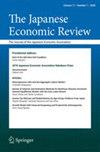日本创业动态:来自Dynemp v.2的比较证据数据库
IF 0.5
4区 经济学
Q2 ECONOMICS
引用次数: 1
摘要
本文描述了2001-2007年期间日本制造业进入和进入后的增长模式,指出了与其他国家的异同。本文还介绍了在制造业部门更详细(两位数)的部门层面上的创业动态的详细特征。分析显示,与其他国家相比,日本初创企业的进入和增长对净就业创造的贡献相对较小。主要原因是创业率特别低,存活下来的新企业的增长率在所分析的样本国家中是最低的。本文章由计算机程序翻译,如有差异,请以英文原文为准。
Start-up Dynamics In Japan: Comparative Evidence From the Dynemp v.2 Database
The present paper describes the patterns of entry and post-entry growth in the Japanese manufacturing sector over the 2001–2007 period, pointing to similarities and differences with other countries. The paper also presents a detailed characterization of start-up dynamics at a more detailed (two-digit) sectoral level within the manufacturing sector. The analysis shows that in Japan the entry and growth of start-ups contribute relatively little to net job creation, as compared to other countries. The main reasons are a particularly low start-up rate and a growth rate of surviving new businesses that is among the lowest in the sample of countries analysed.
求助全文
通过发布文献求助,成功后即可免费获取论文全文。
去求助
来源期刊

Japanese Economic Review
ECONOMICS-
CiteScore
2.70
自引率
0.00%
发文量
15
期刊介绍:
Started in 1950 by a group of leading Japanese economists under the title The Economic Studies Quarterly, the journal became the official publication of the Japanese Economic Association in 1959. As its successor, The Japanese Economic Review has become the Japanese counterpart of The American Economic Review, publishing substantial economic analysis of the highest quality across the whole field of economics from researchers both within and outside Japan. It also welcomes innovative and thought-provoking contributions with strong relevance to real economic issues, whether political, theoretical or policy-oriented.
 求助内容:
求助内容: 应助结果提醒方式:
应助结果提醒方式:


